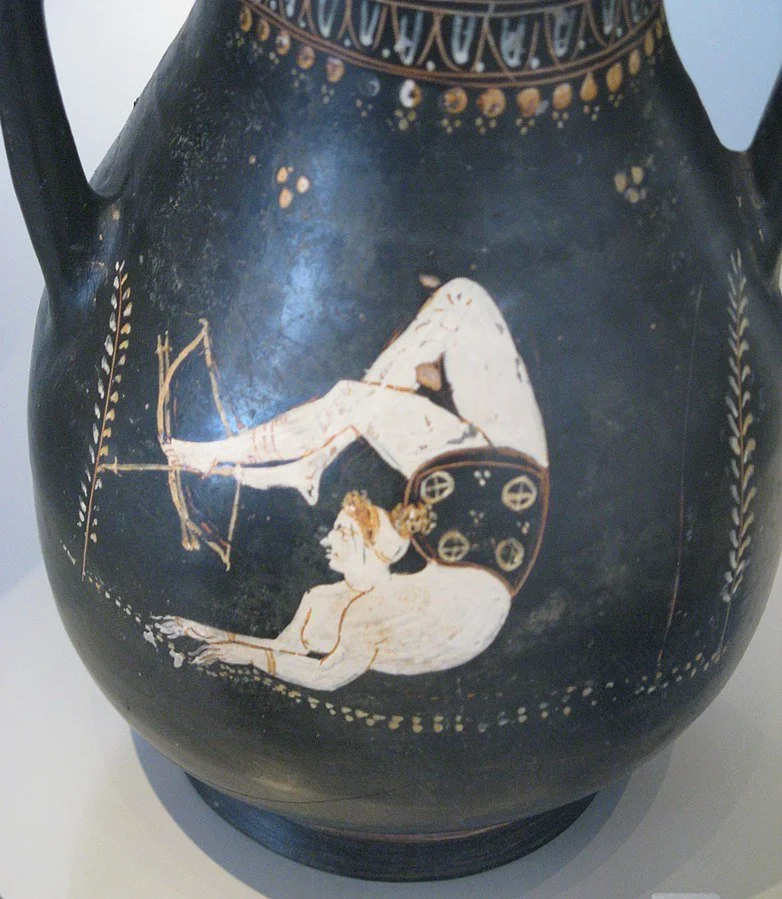The art of archery has long been revered across cultures, not only as a means of survival but also as a platform for artistic expression and athletic prowess. A striking example of this tradition is depicted in the juxtaposition of two images: an Ancient Greek pelike (a type of pottery) from the 4th century BC and a modern acrobatic archer performing at the 2016 World Nomad Games in Kyrgyzstan. Both images illustrate the timeless fascination with the combination of flexibility, precision, and skill in archery, a discipline that spans centuries and continents.
Ancient Greece: Archery as an Artistic Expression
Female acrobat shooting an arrow with a bow in her feet; Gnathia style pelikai; 4th century B.C.
This image features a black-figure pelike, a type of ceramic vessel used in Ancient Greece for storing liquids such as wine or oil. This particular pelike, dated to the 4th century BC, is remarkable for its depiction of a female acrobat shooting an arrow with her feet. The scene showcases not just a mastery of archery but also an impressive display of physical dexterity and balance. Such imagery underscores the cultural appreciation for athleticism and artistry in Ancient Greece.
In Ancient Greek society, depictions of acrobatic feats were often intertwined with themes of mythology, celebration, and entertainment. While it is unclear whether this image represents a specific mythological character or a real performer, it serves as evidence that such performances were both admired and recorded in art. The artistic medium of pottery provided a way to immortalize these feats, blending functional objects with storytelling.
Modern Kyrgyzstan: Archery as a Cultural Tradition
Fast-forwarding to 2016, the second image captures a female acrobatic archer performing at the World Nomad Games in Kyrgyzstan. This event is an international celebration of nomadic culture, featuring traditional sports, music, and rituals from countries across Central Asia and beyond. The archer, balancing upside down and drawing a bow with her feet, is emblematic of the same values of strength, precision, and grace seen in the ancient depiction.
In Kyrgyz culture, archery holds a historical significance as a vital skill for survival and warfare. The inclusion of acrobatic archery in the World Nomad Games highlights its evolution into a modern performance art that honors traditional roots while captivating contemporary audiences. These games serve as a platform to preserve and showcase the rich cultural heritage of nomadic societies, bridging the past and the present.
Parallels Between Ancient and Modern Practices
Though separated by millennia, the two images demonstrate striking parallels. Both the Ancient Greek artist and the modern-day performer celebrate the extraordinary capabilities of the human body and its ability to master complex skills. The use of feet to draw and shoot a bow—an act requiring exceptional flexibility and control—is a shared focal point, symbolizing the ingenuity and dedication of these individuals.
Moreover, both contexts highlight how archery transcends its practical use as a weapon or tool, transforming into a spectacle of artistic and athletic excellence. This enduring appeal speaks to humanity’s fascination with pushing physical limits and expressing cultural identity through performance.
The juxtaposition of the Ancient Greek pelike and the modern acrobatic archer at the World Nomad Games offers a compelling narrative about the continuity of human creativity and skill. While the settings and purposes may differ, both instances celebrate the extraordinary potential of the human spirit. From the artisans of Ancient Greece to the performers of contemporary Kyrgyzstan, acrobatic archery remains a powerful symbol of cultural pride and human achievement, connecting us across time and geography.











